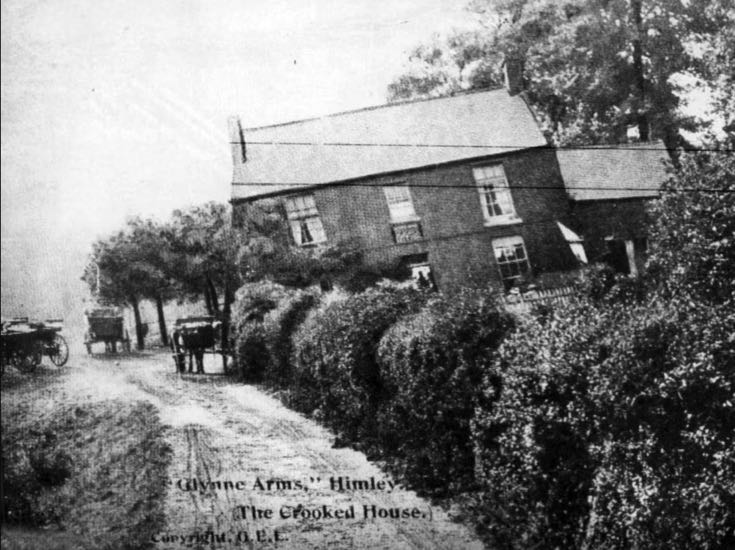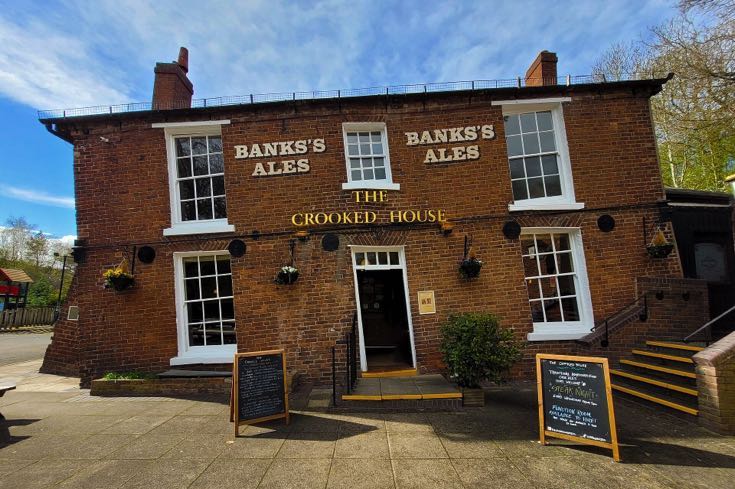In the village of Himley in Central England there once stood a crooked pub. Known as the Crooked House on account of its leaning walls and the tilting foundation onto which it was built, it was not only a favourite of the locals but also something of a tourist attraction. In July of 2023 the pub was sold to a quarrying and landfill company that existed adjacent to it, with a mysterious fire hitting it the following month. In the wake of the fire, the new owners defied the orders of the local council and used bulldozers to clear the land. The council responded by ordering it to be rebuilt exactly as it was by 2027.
The History of the Crooked House

In 1765, the building was created in order to be corn mill on Oak Farm, which was located on the Glynne estate in Himley, Staffordshire. It remained a corn mill until about 1830, which was when it was turned into a pub for the first time and re-named as the Glynne Arms. This was around the time that coal mines were being established in the Black Country, with the Early of Dudley owning the Himley colliery in the location around the pub. By the 1850s, the pub had started to sink at one end until it was four foot lower than the other end, the building had a lean of 15 degrees. It was thought the mining near to the building led to the subsidence.
It is also possible that the mill race caused softening of the surrounding ground, but whatever the reason for it the pub stood at an angle. Locally, it because known as ‘Siden House’, with ‘siden’ being a word for crooked in the dialect of the Black Country. Buttresses were used to strengthen it in 1904, but in the 1940s it was condemned as unsafe and was scheduled to be demolished. In 1957, with no demolition having taken place, Wolverhampton and Dudley Breweries bought the building and in 1957 made it safe. That was done using steel tie rods and by strengthening the pre-existing buttresses, with around £10,000 invested.
That is the equivalent of about £260,000 in modern terms. In 1986 a fire saw the pub damaged further, affecting the first floor as well as the roof. The brewery needed to invest in it again, this time spending the equivalent of around £1 million on the necessary renovations. Inside the pub, the leaning walls gave way to optical illusions that included objects looking as though they were rolling uphill. Both furniture and fittings seemed to sit in a way that wasn’t plumb, which included a grandfather clock and chandelier. The landlord of the pub in the 1970s claimed that its unusual look brought in punters from the likes of China and the United States of America.
The 2023 Sale
Known as ‘Britain’s Wonkiest Pub‘, the building was put up for sale in the March of 2023 with an asking price of £675,000. Although it was sold as a ‘going concern’, there was a fear that it wouldn’t open its doors again after it was bought by a private buyer with the aim being that it would face an ‘alternative use’. On the 25th of June, though, the pub was the subject of a burglary, with more than £10,000 worth of damage being done to the kitchen, the toilet areas and the bar. In July, an appeal was made to Historic England to give the building listed status, with the Georgian Group looking to see if it should be a listed site.
It was on the 27th of July that the pub was eventually sold for an undisclosed price, with that also being the point at which the ‘alternative use‘ of the pub was first mentioned. It was later revealed that the buyer was ATE Farms, which was a property firm that had the same registered address as a quarrying firm that was based adjacent to the pub. The address in Bedworth, Warwickshire was also where an equipment rental firm by the name of AT Contracting and Plant Hire was based. It looked as though the future of the Crooked House was one in which it would not be used as a pub, but instead as something else entirely.
A Mysterious Fire
On the fifth of August as darkness fell, a fire broke out at the pub. It gutted the interior completely, destroying part of the pub’s overall structure, including the roof. Whilst no people were reported injured, there was a dirt mound that measured approximately eight foot blocking the only lane down to it. This meant that the fire crews from both Staffordshire Fire and Rescue Service and the West Midlands Fire Service were unable to gain access to work to put the fire out. In the end, around 1,000 metres of hose were used in order to get water to the fire and look to extinguish it as quickly as it was possible to.
In the days that followed the fire, Staffordshire Fire and Rescue Service and Staffordshire Police launched an investigation together, with the aim being to see if they could discover the cause of the fire. Perhaps most importantly, at least in terms of this story, is the fact that representatives of South Staffordshire Council attended the site with a representative of the land owner and a plan of works was discussed. The likes of removing parts of the first floor of the front elevation, done in order to remove the risk of weakened parts of the building falling, was planned, whilst council officers felt there was no need to have the entire structure demolished.
On the seventh of August, investigations were begun behind a police cordon, only for the police officers stationed there to be recalled on account of the fact that the building was thought to be structurally unsafe. As a result, it was the landowner who oversaw the site, with an excavator being hired by AT Contracting and Plant Hire in order to demolish the building. The plant hire company later said that the excavator had been on dry hire to a customer already, with the supplier claiming that it had no foreknowledge of the demolition of the pub nor any connection to the decision to demolish against the council’s instructions.
What Happened Next
The leader of South Staffordshire Council, Roger Lees, said that the demolition was ‘completely unacceptable and contrary to instructions’ that the council officers had provided. As a result, a decision was taken to pass the case to the Council Planning Enforcement Department in order to see whether or not the demolition was lawful in accordance with the Town and Country Planning Act and the Building Act. Legislation that had been breached during the demolition were referred to the Health and Safety Executive. The Mayor of West Midlands, Andy Street, made a call for the pub to be rebuilt ‘brick by brick’.
Street also moved to urged the SSC to block attempts to change the use of the building from a pub. On the ninth of August 2023, Staffordshire Police confirmed that they were treating the circumstances as arson as long as the fire service were continuing their investigations into the cause of the fire. It also emerged that AT Contracting and Plant Hire had experienced a major fire in the August of 2018 at a landfill site of theirs in Finmere, Buckinghamshire, the cause of which had never been established. Over the course of the next few months, several people were arrested and then bailed by Staffordshire Police on suspicion of arson with intent endanger life.
In the February of 2024, South Staffordshire Council confirmed that it had ‘engaged with the owners’ of the pub and ordered that it be re-built to ‘what it was prior to the fire’. The re-build had to be completed by the February of 2027 or else they would face prosecution on account of the fact that they had failed to comply with the order. Adam and Carly Taylor, the owners of the pub since the sale, as well as the ATE Farms company secretary, were served with the notice and given 30 days to appeal it. Roger Lees said the following:
We have not taken this action lightly, but we believe that it is right to bring the owners, who demolished the building without consent, to account and we are committed to do what we can to get the Crooked House rebuilt.
There was certainly a desire amongst the public to see the Crooked House restored to its former glory, with more than 35,000 people joining the Save The Crooked House (Let’s Get It Re-Built) Facebook page. Quite whether the fire was started deliberately or the new owners wanted the building demolished in order to use the land as an extension of their business that stood to the side of it may never be known. What we do know, though, is that the house should be back in its former state by 2027 or else the owners will face the consequences.

